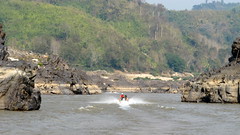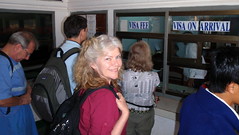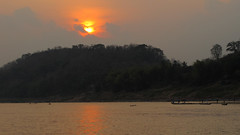 The towns of Chiang Khong in northern Thailand and Huay Xai in Laos straddle the Mekong River that defines their common border. Both are heavily reliant on the steady flow of tourists beginning the “classic” boat trip down the Mekong to Luang Prabang.
The towns of Chiang Khong in northern Thailand and Huay Xai in Laos straddle the Mekong River that defines their common border. Both are heavily reliant on the steady flow of tourists beginning the “classic” boat trip down the Mekong to Luang Prabang.A burst of activity every morning brings ferry loads of people from the Thai side to wait in immigration lines on the Laotian side before boarding various classes of boat for the downstream journey.
 The “fast boats” can make it in seven hours, but the 5–6 people on board have a bumpy, noisy ride, and the helmets they need to wear makes picture-taking impractical.
The “fast boats” can make it in seven hours, but the 5–6 people on board have a bumpy, noisy ride, and the helmets they need to wear makes picture-taking impractical.The “slow boats” take two days, with an overnight stop in Pak Beng. The public versions have wooden benches, and pack in as many people as possible. These are commercial river boats, so can stop for passengers along the way. Many such boats take turns operating as luxury boats, wherein the wooden benches are replaced by comfortable upholstered seats, and carry a limited number of people.
 We had been planning to take a slow boat, but were becoming apprehensive after reading forums where people described sore bottoms from hard seats, being stuck in direct sun, excessive drinking and cigarette smoke — as well as a general melee for getting seats and then finding accommodation in Pak Beng. It was beginning to sound like a hassle instead of a highlight.
We had been planning to take a slow boat, but were becoming apprehensive after reading forums where people described sore bottoms from hard seats, being stuck in direct sun, excessive drinking and cigarette smoke — as well as a general melee for getting seats and then finding accommodation in Pak Beng. It was beginning to sound like a hassle instead of a highlight.Amongst the horror stories in a forum thread about the slow boats, one comment about a positive experience prompted me to email Adisak at Nagi of Mekong — despite some followup responses that made him sound unreliable. I got a response immediately. Not only was he prompt, but provided details for days and costs. We had no specific dates at that time, but kept in touch, and by the time we were ready, we let him know. He booked our selected hotel in Chiang Khong (their web site was broken), and picked us up the morning of the cruise. We fully expected to be part of a larger group, but learned that we were alone with one other couple: the entire boat and an English-speaking Lao guide for two days!
 Adisak crossed with us and helped by explaining the crazy immigration process: everyone pushes and congregates at three mall windows as the very methodical Laotian officials process the passports and take cash for the visas as if there was no crowd at all. Knowing that there is a process — however bizarre it may seem — made it a lot easier to cope with!
Adisak crossed with us and helped by explaining the crazy immigration process: everyone pushes and congregates at three mall windows as the very methodical Laotian officials process the passports and take cash for the visas as if there was no crowd at all. Knowing that there is a process — however bizarre it may seem — made it a lot easier to cope with!Passports with new visas in hand, we were whisked off to the boat, where our bags and the other couple were waiting. We thanked Adisak for his help and he waved as we pushed off. We only then realized he hadn’t asked for payment. When I asked Pet, our Lao guide, he nodded and smiled. “It’s okay, pay later.” (We did!)
As we passed the first of the public boats loading up, we were glad to have paid the premium as people with big bags scrambled up to claim the good seats. Slower people, or those less fortunate in the immigration process, would have noisier seats near the back or be stuck on middle of a bench.
The public boat ticket prices are much lower, but an accurate comparison is hard to make. Different sellers charge different rates, and the boats rotate in service, so quality can vary. I spoke to one couple who had paid 1,200 THB each (~C$38) — but then had to pay for the ferry across the river, plus a tuk tuk to take them and their bags to the dock, plus food on board, plus a dismal room in Pak Beng…
For 4,600 THB (~C$144), we had comfortable seats, excellent food on board, a well-informed English-speaking guide, several interesting stops, and a comfortable room with breakfast in Pak Beng.
 All of the logistics were looked after for us, so there was almost no stress. We arrived in Luang Prabang feeling relaxed and stimulated.
All of the logistics were looked after for us, so there was almost no stress. We arrived in Luang Prabang feeling relaxed and stimulated.The extra cost was a very small price to pay for an unforgettable, once-in-a-lifetime trip.
